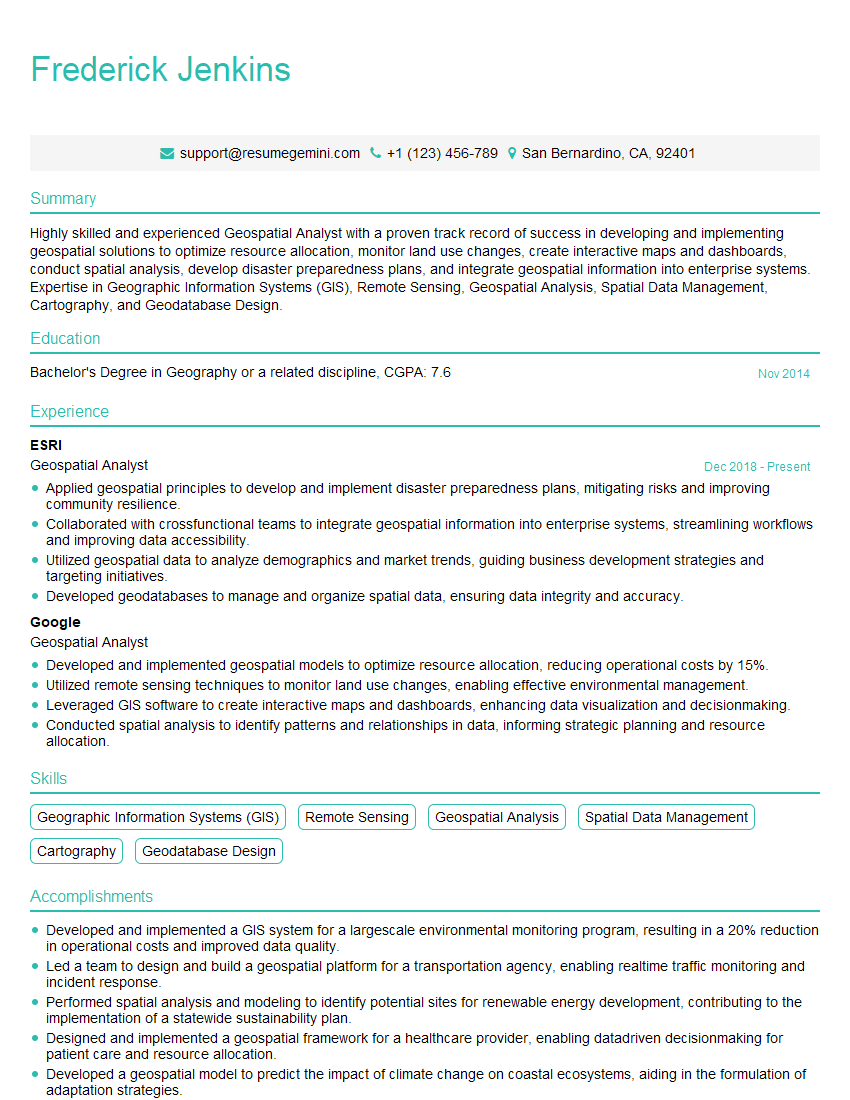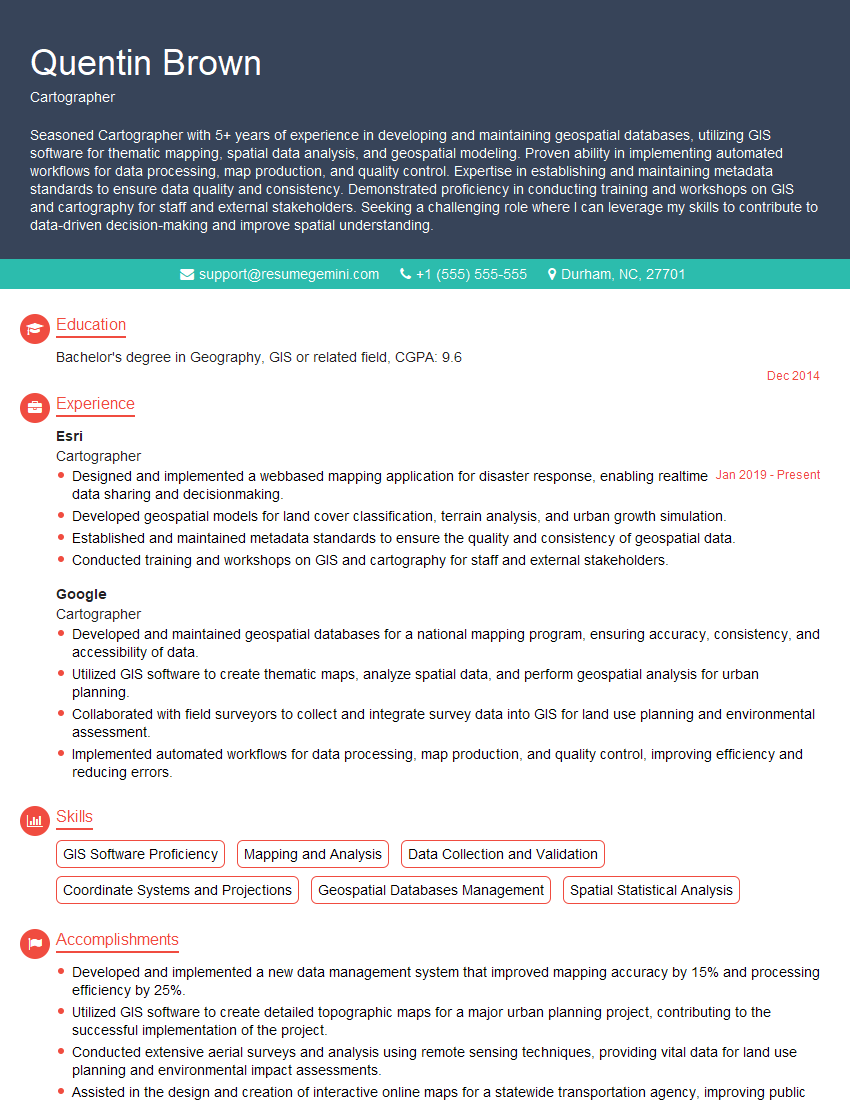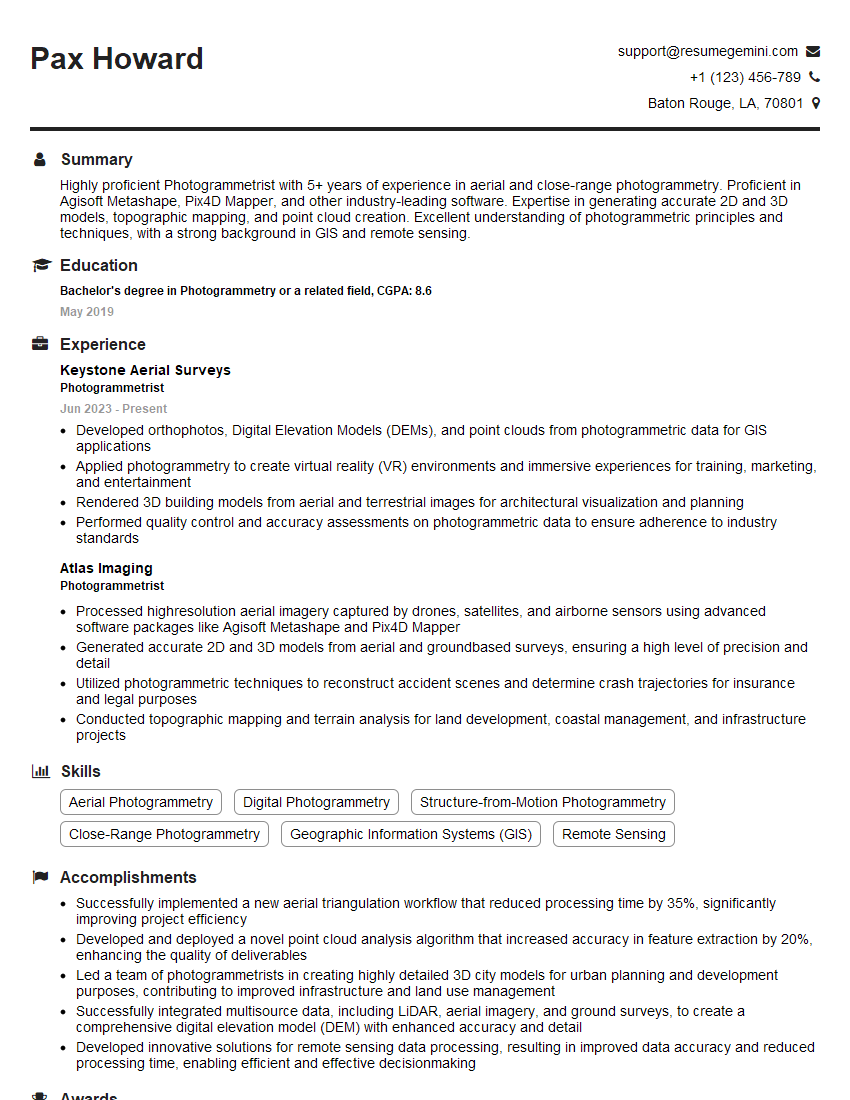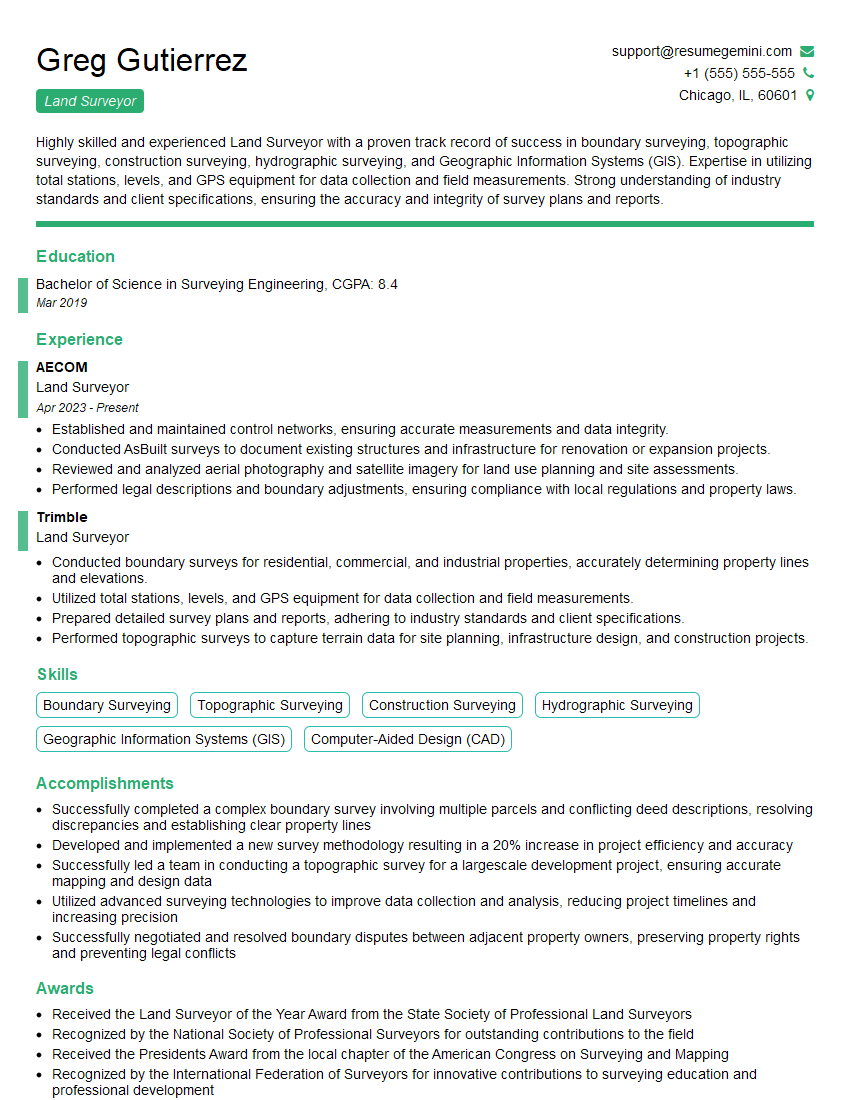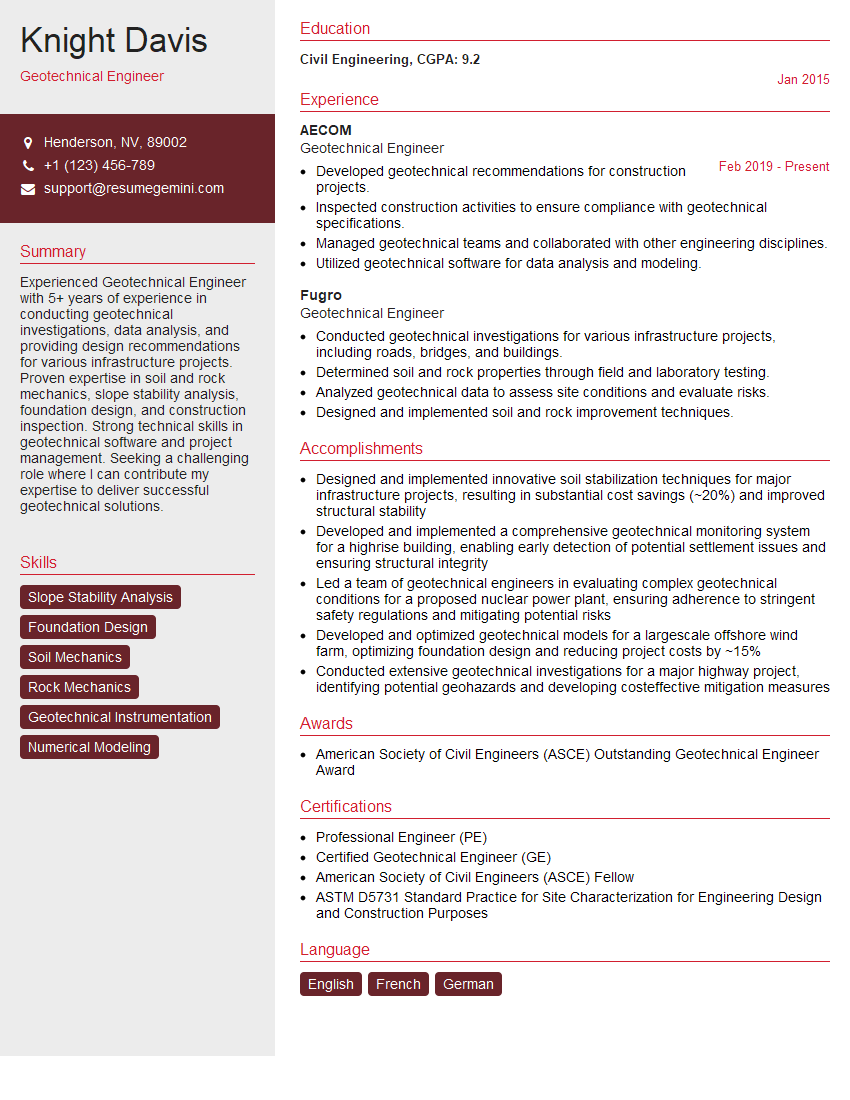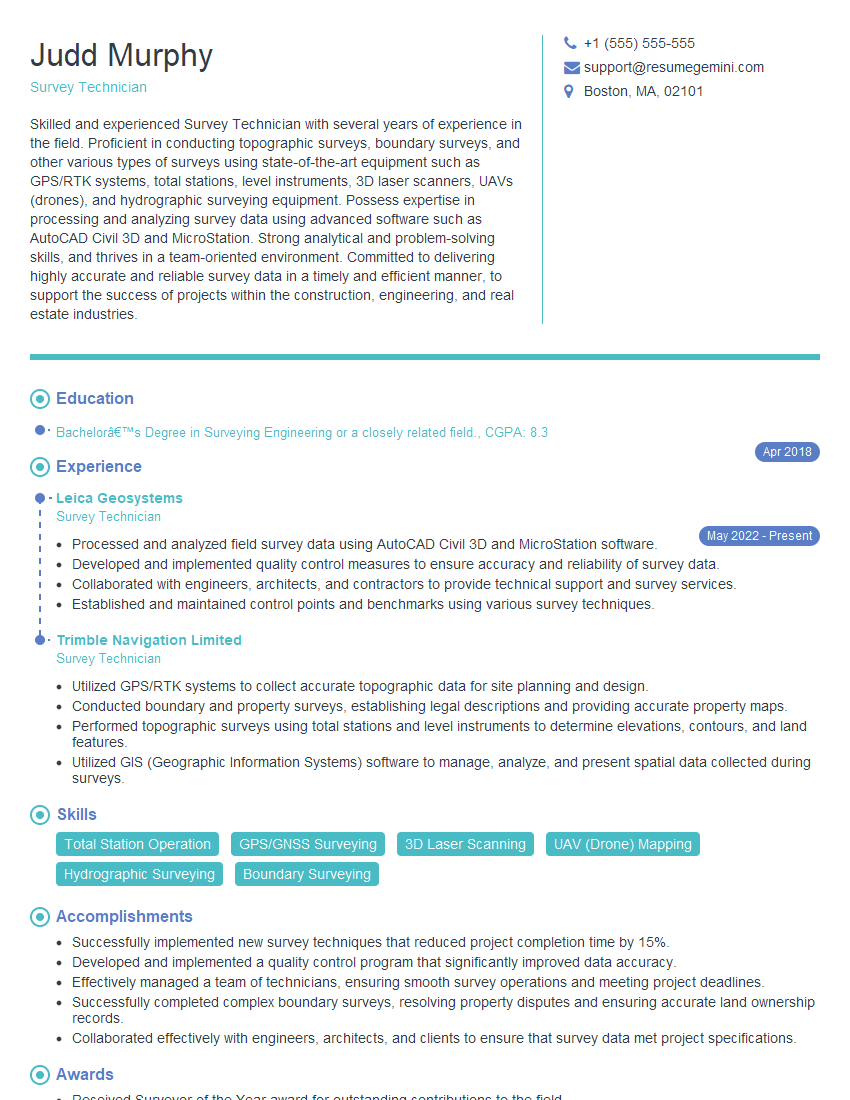Interviews are opportunities to demonstrate your expertise, and this guide is here to help you shine. Explore the essential Experienced in using survey software for terrain modeling interview questions that employers frequently ask, paired with strategies for crafting responses that set you apart from the competition.
Questions Asked in Experienced in using survey software for terrain modeling Interview
Q 1. What survey software packages are you proficient in (e.g., AutoCAD Civil 3D, ArcGIS, etc.)?
My expertise in survey software for terrain modeling spans several leading packages. I’m highly proficient in AutoCAD Civil 3D, leveraging its powerful tools for surface creation, analysis, and design. I’m also experienced with ArcGIS, particularly its spatial analysis capabilities for handling large datasets and performing geoprocessing tasks relevant to terrain modeling. Additionally, I have working knowledge of Global Mapper, appreciating its versatility in handling various data formats and its strong visualization tools. My choice of software depends heavily on the project’s specific needs and the data format available. For instance, if the project involves extensive road design and earthworks calculations, AutoCAD Civil 3D’s features are invaluable. Conversely, for complex spatial analyses involving multiple datasets, ArcGIS’s geoprocessing tools are preferable.
Q 2. Describe your experience with data import and preprocessing in terrain modeling.
Data import and preprocessing is a crucial, often time-consuming, step in terrain modeling. My experience encompasses various data formats, including point clouds (from LiDAR or total stations), raster data (DEMs from satellite imagery), and vector data (contours from existing maps). The process typically begins with a thorough quality check for obvious errors or inconsistencies. I then use software tools to import the data, clean it (removing outliers or duplicates), and transform it to a consistent coordinate system (e.g., UTM). For example, with LiDAR data, I’ll often use filtering techniques to remove ground noise or classify points into different categories (ground, vegetation, buildings). For raster data, I may need to perform georeferencing to accurately align it with the project area. Preprocessing is key to ensuring the accuracy and reliability of the final terrain model. Think of it like preparing ingredients before baking a cake – you can’t have a perfect cake without proper preparation.
Q 3. Explain the difference between various terrain representations (TIN, DEM, DTM).
The terms TIN, DEM, and DTM are often used interchangeably, but they represent distinct aspects of terrain representation. A Triangulated Irregular Network (TIN) is a vector-based representation composed of interconnected triangles, each defined by three points with elevation values. It’s excellent for representing detailed terrain with sharp changes in elevation, such as cliffs or man-made features. A Digital Elevation Model (DEM) is a raster-based representation of terrain elevation, typically a grid of cells, each with an assigned elevation value. DEMs are commonly derived from satellite imagery or LiDAR data. They provide a smoother representation of the terrain compared to TINs. Finally, a Digital Terrain Model (DTM) is a specific type of DEM that only represents the bare earth surface, excluding vegetation and man-made features. Essentially, a DTM focuses on the natural terrain. Imagine a mountain range: a TIN would capture the sharp peaks and valleys precisely, a DEM would give a smoother representation, and a DTM would remove the trees and buildings to show only the underlying rock and soil.
Q 4. How do you handle errors and inconsistencies in survey data?
Handling errors and inconsistencies is a critical part of my workflow. I use a multi-pronged approach. First, visual inspection plays a major role. I carefully examine the data using the software’s visualization tools to identify outliers or improbable elevations. Statistical analysis, such as identifying data points falling outside a specific standard deviation, helps quantify the extent of errors. For example, if I’m working with point cloud data and notice a cluster of points with unexpectedly high elevations, I might investigate whether it’s due to a measurement error or an actual feature (like a building). Software tools often allow editing or flagging problematic data points. In some cases, interpolation techniques can help fill gaps or smooth out inconsistencies, but this must be done carefully to avoid introducing bias. Finally, I always document any decisions made during the error handling process for transparency and reproducibility.
Q 5. What techniques do you use for data quality control in terrain modeling?
Data quality control is paramount in terrain modeling. I employ several techniques throughout the process. This starts with verifying the accuracy of the source data – checking metadata, comparing with existing maps, and assessing the data acquisition method’s limitations. During preprocessing, I employ filtering techniques to remove noise and outliers as described previously. After creating the terrain model, I perform visual checks for artifacts or inconsistencies. Furthermore, I might compare the generated model with existing data or ground truth measurements to assess accuracy. Statistical measures, like root mean square error (RMSE), can quantify the deviation between the model and reference data. Finally, I always maintain detailed documentation of the data sources, processing steps, and quality control checks for future reference and verification.
Q 6. Describe your experience with different interpolation methods (e.g., IDW, kriging).
Interpolation methods are crucial for estimating elevation values at unsampled locations. Inverse Distance Weighting (IDW) is a simple method that assigns weights inversely proportional to the distance from known data points. It’s computationally efficient but can produce artifacts if the data distribution is uneven. Kriging is a more sophisticated geostatistical method that considers spatial autocorrelation – the correlation between values at nearby locations. It provides more accurate and smoother interpolation, especially when dealing with spatially autocorrelated data, but it’s more computationally intensive and requires understanding of the underlying spatial variability. My choice depends on the project’s requirements and data characteristics. For instance, a preliminary analysis might use IDW for quick results, while a final model for critical applications might utilize kriging for higher accuracy. The advantages and disadvantages of each are carefully weighed depending on the specific situation.
Q 7. How do you create contour lines from a digital elevation model (DEM)?
Generating contour lines from a DEM is a standard procedure in most terrain modeling software. The process typically involves specifying a contour interval (the vertical spacing between contour lines) and running a contouring algorithm. Most software packages provide automated tools for this task. The algorithm essentially identifies points on the DEM that lie at specific elevation levels and then connects those points to create the contour lines. The resulting contour lines can then be visualized and exported as vector data for further analysis or use in design applications. For instance, in a hydrological study, these contours can be used to delineate watersheds and analyze water flow patterns. Similarly, in civil engineering, contours are essential for site planning, earthworks calculations, and road design.
Q 8. How do you assess the accuracy of a terrain model?
Assessing the accuracy of a terrain model is crucial for ensuring its reliability in applications like construction, environmental impact studies, and infrastructure planning. Accuracy is evaluated through a combination of methods, focusing on both positional accuracy (how well points are located in 3D space) and attribute accuracy (how well features like elevation are represented).
We typically use Root Mean Square Error (RMSE) to quantify positional accuracy. This statistical measure tells us the average difference between the model’s elevations and the actual ground elevations at a set of check points. Lower RMSE values indicate higher accuracy. For example, an RMSE of 0.1 meters suggests a very accurate model suitable for precise engineering tasks, while a higher RMSE of 1 meter might suffice for broader land-use planning.
Attribute accuracy, on the other hand, involves comparing derived parameters like slope or aspect calculated from the model to field measurements or reference data. We might compare the model’s calculated slope to that obtained through direct field surveys, using statistical measures to assess the difference. A visual inspection using cross-sections and profiles also helps to identify potential areas of inaccuracy. Regular quality control checks during data processing and modelling are essential to prevent the accumulation of errors.
Q 9. Explain your experience with LiDAR data processing and point cloud analysis.
My experience with LiDAR data processing and point cloud analysis is extensive. I’m proficient in using various software packages like LAStools, ArcGIS Pro, and CloudCompare for processing massive point clouds. This involves tasks such as filtering (removing noise and outliers), classification (categorizing points as ground, vegetation, buildings etc.), and georeferencing (assigning accurate geographic coordinates).
For instance, on a recent project involving a landslide assessment, we used LiDAR data to create a highly accurate digital terrain model. After filtering the raw point cloud to remove noise from vegetation and man-made objects, we classified the ground points and interpolated a digital elevation model (DEM) with a very fine resolution. This DEM was critical in identifying subtle changes in ground elevation indicative of ground movement, aiding in accurate landslide risk assessment. This involved using tools to delineate breaklines and incorporate those into the interpolation to ensure the final DEM was accurate and representative of the actual terrain.
Point cloud analysis also allows for the extraction of various features, including building footprints, tree heights, and even individual rocks, depending on the LiDAR’s resolution. I am also familiar with visualizing point clouds and extracting features using scripting languages like Python with libraries such as Pandas and GDAL.
Q 10. How do you integrate survey data with other geospatial data sources?
Integrating survey data with other geospatial data sources is fundamental to building comprehensive terrain models. Survey data, often providing high-accuracy localized information, is enriched by incorporating data from sources like satellite imagery, aerial photographs, and other existing spatial datasets.
For example, we might use high-resolution satellite imagery to provide contextual information, such as land cover classification, and integrate it with precise elevation points from a ground survey. This is typically achieved through georeferencing all data to a common coordinate system and utilizing a GIS software like ArcGIS Pro to overlay and manage these various layers.
Data fusion techniques are often employed to leverage the strengths of each dataset. For instance, we might use satellite imagery to improve the classification of points in a LiDAR point cloud, or use a higher resolution DEM to refine a coarser DEM derived from satellite data. A well-integrated dataset significantly improves the model’s accuracy and detail, offering a more holistic and informative representation of the terrain.
Q 11. Describe your experience with creating 3D terrain models.
Creating 3D terrain models involves several steps, starting with data acquisition (e.g., LiDAR, photogrammetry, or traditional surveying). Then, data processing is crucial to clean and prepare the data for modelling. This often includes noise removal, outlier detection and removal, point cloud classification, and georeferencing.
The next stage involves interpolating a digital elevation model (DEM) from the processed data. Various interpolation methods exist, such as kriging, inverse distance weighting, and spline interpolation, each with its strengths and weaknesses. The choice of method depends on the data distribution, desired accuracy, and computational resources.
After generating the DEM, I usually use specialized software to create the 3D terrain model. This might involve draping imagery or textures onto the DEM to enhance visualization. I often use software like ArcGIS Pro, Global Mapper or specialized point cloud processing software to create these models. The final product might be a simple visualization or a highly detailed model including various features and layers, depending on the project needs. A recent project involved creating a 3D model of a proposed highway route, integrating the terrain model with road design plans to analyze potential environmental impacts.
Q 12. How do you handle large datasets in terrain modeling?
Handling large datasets in terrain modeling requires strategic approaches to avoid computational bottlenecks and ensure efficient processing. This involves utilizing techniques like data tiling, parallel processing, and optimized algorithms.
Data tiling involves breaking down the large dataset into smaller, manageable tiles. Processing these tiles independently and then combining the results significantly reduces processing time and memory requirements. This is especially helpful when dealing with massive point clouds or high-resolution raster data.
Parallel processing, leveraging multi-core processors or cloud computing resources, allows for simultaneous processing of multiple tiles, further accelerating the workflow. Selecting efficient algorithms and data structures is crucial, as poorly optimized code can lead to significant slowdowns when handling large datasets. For instance, using optimized libraries and avoiding unnecessary data copying can greatly enhance performance. I use cloud computing platforms such as AWS or Google Cloud to effectively manage extremely large datasets for computationally intensive processing tasks.
Q 13. What are the common challenges you face during terrain modeling projects?
Terrain modeling projects often face several challenges. One common issue is data quality. Inconsistent data from different sources, missing data, or noisy data can significantly impact model accuracy. Data acquisition itself can be challenging in difficult-to-access areas or under adverse weather conditions.
Another challenge is selecting the appropriate interpolation method. Different methods yield varying results, and the best choice often involves careful consideration of the data characteristics and project requirements. Computational limitations can also be significant, especially when dealing with vast datasets and computationally intensive algorithms. This necessitates careful planning of processing strategies and efficient use of computing resources.
Finally, ensuring the model’s usability and interpretability is key. The model’s complexity should be balanced with its intended application. An overly complex model might be difficult to interpret and use, whereas an oversimplified model might lack crucial details. For example, a model meant for visual representation might have different accuracy requirements than one used for engineering calculations.
Q 14. Describe your experience with terrain analysis techniques (e.g., slope, aspect, hillshade).
Terrain analysis techniques, like slope, aspect, and hillshade, provide valuable information about the terrain’s characteristics. These are derived from the DEM and used extensively in various applications.
Slope analysis quantifies the steepness of the terrain, which is critical in applications like hydrological modelling, slope stability assessment, and road design. Aspect analysis determines the direction a slope faces (e.g., north, south, east, west), which is crucial for understanding solar radiation patterns, vegetation distribution, and microclimate. Hillshade analysis creates a shaded-relief image that enhances the visual representation of the terrain, making it easier to identify features like valleys, ridges, and peaks.
I’ve used these techniques extensively in several projects. For example, in a forestry project, slope and aspect analysis were used to predict areas suitable for reforestation based on terrain suitability and sunlight exposure. In another project involving erosion analysis, slope analysis helped identify areas prone to erosion based on slope gradients. These analyses are often incorporated into GIS workflows to produce maps and visualizations that provide valuable insights into terrain characteristics and their impact on different environmental processes.
Q 15. How do you use terrain models for hydrological analysis or volume calculations?
Terrain models are invaluable for hydrological analysis and volume calculations. Imagine a digital twin of the landscape – that’s essentially what a terrain model provides. For hydrological analysis, we can use the model to simulate water flow, determine drainage patterns, and estimate runoff volumes. This is crucial for flood risk assessment, designing drainage systems, and managing water resources. For volume calculations, the model allows us to accurately determine the volume of earthworks, such as excavations or embankments, needed for construction projects. This is done by calculating the volume between the terrain surface and a designed surface. For example, to calculate the cut and fill required for a road construction project, we would compare the existing terrain model with a digital model representing the planned road profile.
Practically, I’ve used software like ArcGIS Pro and QGIS to perform these analyses. In ArcGIS Pro, for instance, the Spatial Analyst extension allows for the creation of hydrological models based on elevation data, enabling the calculation of flow accumulation, flow direction, and watershed delineation. The volume calculation is usually done using tools that compute the difference between two surfaces. For instance, we can use the ‘Surface Volume’ tool in ArcGIS Pro or similar tools in other GIS software to determine cut and fill volumes. This information directly influences the project budget and scheduling.
Career Expert Tips:
- Ace those interviews! Prepare effectively by reviewing the Top 50 Most Common Interview Questions on ResumeGemini.
- Navigate your job search with confidence! Explore a wide range of Career Tips on ResumeGemini. Learn about common challenges and recommendations to overcome them.
- Craft the perfect resume! Master the Art of Resume Writing with ResumeGemini’s guide. Showcase your unique qualifications and achievements effectively.
- Don’t miss out on holiday savings! Build your dream resume with ResumeGemini’s ATS optimized templates.
Q 16. Explain your understanding of coordinate systems and projections.
Coordinate systems and projections are fundamental to geospatial data. Think of the Earth as a sphere – representing its surface accurately on a flat map requires a projection. A coordinate system defines the location of a point using numerical coordinates (like latitude and longitude), whereas a projection transforms the three-dimensional Earth’s surface onto a two-dimensional plane. Different projections distort the shape, area, or distances in various ways. The choice of projection depends on the specific application and the region of interest. For example, the UTM (Universal Transverse Mercator) projection is commonly used for large-scale mapping because it minimizes distortion within its zones. Conversely, the Geographic Coordinate System (GCS), using latitude and longitude, is less distortion-free, but useful for global representations.
My experience involves working with various coordinate systems, including UTM, State Plane Coordinate Systems (SPCS), and geographic coordinates (latitude/longitude). I’m proficient in defining and transforming coordinates between different systems using GIS software. This is particularly crucial when integrating data from multiple sources, ensuring consistency and accuracy. Incorrect coordinate systems would lead to errors in location, distance, and area calculations. For example, a slight misalignment in coordinate systems can cause errors in overlapping data sets or lead to inaccurate positioning of objects in a terrain model, making the model unreliable for engineering designs or analysis.
Q 17. Describe your experience with GPS and RTK surveys.
GPS (Global Positioning System) and RTK (Real-Time Kinematic) GPS are essential technologies for acquiring high-accuracy spatial data. GPS uses satellite signals to determine the approximate location of a receiver. RTK GPS enhances the accuracy significantly by using a base station with a known precise location, and correcting the measurements of the rover GPS receiver in real time. RTK surveys are often necessary for high-precision work such as engineering, construction and cadastral mapping. The rover’s position is corrected using data from the base station, resulting in centimeter-level accuracy. GPS surveys provide less precise data but can still be useful for broad-area mapping, where high accuracy isn’t as crucial.
In my experience, I’ve extensively used both GPS and RTK GPS systems. For example, during a recent project for creating a detailed terrain model for a dam construction site, we employed an RTK GPS system to capture highly accurate elevation points. The accuracy of the RTK survey was essential for the dam’s structural integrity and overall safety. On other projects, basic GPS has been sufficient for mapping the broader extent of the site or conducting preliminary investigations. The key difference lies in the required accuracy of the data – high-precision jobs require RTK, while less demanding projects may benefit from the faster and less-costly use of a standard GPS.
Q 18. How familiar are you with different data formats used in terrain modeling (e.g., LAS, XYZ, SHP)?
Terrain modeling uses several data formats to represent the surface’s topography. LAS files store point cloud data, typically from LiDAR surveys; XYZ files represent points with their X, Y, and Z coordinates; and SHP (Shapefile) files are commonly used for vector data, often representing boundaries or other features. Understanding these formats is essential to work effectively with the data. Each format has strengths and weaknesses – LAS files contain rich information about each point but are larger than XYZ, while XYZ is a simple, widely supported format but lacks metadata.
My familiarity with these formats is extensive. I regularly work with LAS files for processing LiDAR data, using software such as LAStools and CloudCompare to filter, classify, and process point clouds. I utilize XYZ files for simpler point datasets, often converting them to other formats for further analysis and visualization. SHP files are integrated to create context within the terrain model, for instance, incorporating boundary lines of land parcels or buildings. The ability to work seamlessly between these formats is essential for integrating various data sources, facilitating a comprehensive terrain model.
Q 19. What are your preferred methods for visualizing terrain models?
Visualizing terrain models is crucial for understanding the landscape and communicating findings effectively. There are numerous methods, each with advantages. Three-dimensional visualizations provide a realistic representation of the terrain, allowing for better perception of slopes, elevations, and features. Contour maps present lines of equal elevation, useful for showing the overall topography. Hillshades create shaded relief maps that emphasize terrain features and slopes, enhancing three-dimensional perception.
My preferred methods include using GIS software like ArcGIS Pro and QGIS for 3D visualization. These programs allow for interactive exploration of the terrain model, enabling rotation, zooming, and the addition of other layers, such as imagery or vector data. I also generate contour maps and hillshades to understand the slope and aspect of the terrain and communicate this information to clients. For instance, when presenting a site plan for a road construction project to stakeholders, combining a 3D view with contour lines provides a clear and comprehensive illustration of the terrain and proposed design, leading to improved stakeholder understanding and project approval.
Q 20. Describe your experience with using terrain models for engineering design or construction planning.
Terrain models are fundamental for engineering design and construction planning. They provide the essential basis for many key tasks. For example, they’re used for designing roads, railways, pipelines, and other linear infrastructure, ensuring that the design accommodates the existing terrain to minimize earthworks and optimize costs. They’re used for calculating cut and fill volumes, optimizing construction sequencing, and managing material transport. They aid in estimating project costs and scheduling. Moreover, terrain models are essential for slope stability analysis, identifying areas prone to landslides or erosion, contributing to safer and more sustainable designs.
In my professional experience, I’ve employed terrain models in several construction projects. One example involved designing a highway bypass. The terrain model was crucial for determining the optimal alignment of the road to minimize earthworks and reduce the environmental impact. The analysis using the terrain model identified areas requiring substantial excavation and other areas where embankments would be necessary. Accurate volume calculations based on the model informed cost estimation and resource allocation for the construction process. Without accurate terrain models, such projects become significantly more complex, expensive, and potentially dangerous.
Q 21. How do you ensure the security and integrity of survey data?
Data security and integrity are paramount. Survey data is often valuable and sensitive, requiring robust measures to protect it. This involves various strategies including secure storage, access control, data backups, and version control. Secure storage involves storing the data on protected servers with restricted access. Access control limits who can view, edit, or delete the data. Data backups ensure that data is recoverable in case of loss or corruption. Version control tracks changes to the data, enabling the recovery of earlier versions if necessary.
My approach to ensuring data security and integrity encompasses all these elements. I store data on secure servers with access controls using established protocols. Regular data backups are implemented, and version control systems like Git are often used for managing project files and maintaining data integrity over time. Furthermore, data quality control checks are incorporated throughout the process, including checking for inconsistencies, outliers, and errors before integration into the terrain model. In essence, a comprehensive approach to data security and integrity is crucial not only to safeguard the data but also to maintain the reliability and accuracy of the terrain model and associated analyses.
Q 22. Describe a situation where you had to troubleshoot a problem with survey data or software.
During a recent project involving the creation of a high-resolution terrain model for a dam construction site, we encountered inconsistencies in the elevation data collected using a total station. After initial processing with our chosen software (TerraScan), we noticed some elevation points were significantly off, creating unrealistic dips and spikes in the model. This wasn’t immediately apparent in the raw data, only after the interpolation and visualization steps.
My troubleshooting involved several steps:
- Data Validation: I first reviewed the field notes and GPS data to check for potential errors in the original measurements or instrument setup. I noticed a slight offset in the base station coordinates.
- Software Review: I carefully examined the TerraScan processing parameters, focusing on the interpolation method and filtering options. We were using kriging; experimenting with Inverse Distance Weighting (IDW) provided a smoother result, although not perfectly aligned with the expected terrain.
- Outlier Detection: I used statistical analysis within the software to identify and flag outlier elevation points. After visual inspection and correlation with the site imagery, many of the outliers were determined to be caused by vegetation interfering with measurements. We had to manually correct these.
- Data Rectification: Finally, after correcting the base station coordinate error and removing/adjusting outliers, we re-processed the data, resulting in a significantly improved and more realistic terrain model.
This experience highlighted the importance of thorough data validation, understanding the limitations of interpolation methods, and having robust quality control procedures in place.
Q 23. How do you stay current with the latest advancements in terrain modeling technology?
Staying current in terrain modeling is crucial. I employ a multi-pronged approach:
- Professional Organizations: Active membership in organizations like ASPRS (American Society for Photogrammetry and Remote Sensing) provides access to conferences, journals, and networking opportunities with leading experts. I attend webinars and workshops regularly to learn about new software and techniques.
- Online Resources: I frequently consult reputable online platforms like research databases (ScienceDirect, IEEE Xplore), industry blogs, and online forums focusing on GIS, remote sensing, and surveying. This provides a continuous flow of updates and insights into current trends.
- Software Updates and Training: I ensure I’m always up-to-date with the latest versions of software like ArcGIS Pro, TerraScan, and QGIS, and actively participate in vendor-provided training courses and webinars to understand new features and functionalities.
- Peer Review and Collaboration: Engaging in peer review of colleagues’ work and actively collaborating on projects with specialists in different aspects of terrain modeling (LiDAR processing, photogrammetry) exposes me to diverse approaches and latest knowledge.
This combination of formal and informal learning helps me stay ahead of the curve and adapt my skills to the ever-evolving field of terrain modeling.
Q 24. What is your experience with automating terrain modeling workflows?
I have extensive experience automating terrain modeling workflows, primarily using Python scripting within ArcGIS Pro and QGIS. Automation significantly boosts efficiency and repeatability.
For instance, in a recent large-scale project involving the creation of Digital Elevation Models (DEMs) from LiDAR data, I developed a Python script to automate the following:
- Data Import and Preprocessing: Automatically import LiDAR point clouds, perform filtering to remove noise and outliers, and classify ground points.
- DEM Generation: Generate DEMs using various interpolation techniques (TIN, IDW, Kriging) based on pre-defined parameters and automatically compare the results using statistical measures.
- Data Export and Quality Control: Export the DEMs in various formats (GeoTIFF, ASCII) and run automated checks on data quality, such as detecting discontinuities and holes in the surface.
These scripts are easily customizable and reusable for different projects, allowing for consistency and saving considerable time compared to manual processing. I also utilize model builder tools within ArcGIS for more visual workflow automation for tasks that don’t require intricate scripting.
Q 25. Explain your experience with managing and organizing terrain model data.
Managing and organizing terrain model data requires a systematic approach, especially when dealing with large datasets. I typically utilize a combination of techniques:
- Geodatabases: For managing spatial data, I leverage geodatabases within ArcGIS, which offer efficient storage, versioning, and data management capabilities. This allows for easy sharing and collaboration amongst team members.
- File Naming Conventions: I employ a consistent and descriptive file naming convention for all data files (e.g., ProjectName_DataType_Date_Version.ext), ensuring easy identification and retrieval.
- Metadata Management: Comprehensive metadata is crucial. I create detailed metadata for each dataset, including information on data source, processing steps, accuracy assessments, and any relevant limitations. This is essential for data quality control and future reference.
- Cloud Storage: For large datasets, I utilize cloud storage solutions like Amazon S3 or Azure Blob Storage. This provides secure and accessible storage for sharing and collaboration.
- Data Versioning and Archiving: I maintain a version history of all data and regularly archive completed projects to ensure data integrity and prevent data loss.
This structured approach ensures data is easily accessible, well-documented, and readily available for future use or analysis.
Q 26. Describe your experience working collaboratively on terrain modeling projects.
Collaboration is integral to successful terrain modeling. I thrive in team environments and have extensive experience collaborating effectively on diverse projects.
My approach includes:
- Clear Communication: I ensure open and regular communication with team members, using various tools such as project management software (Jira, Asana), email, and regular meetings to coordinate tasks and address any challenges.
- Shared Data Repositories: Employing shared data repositories (cloud storage or network drives with access controls) allows team members easy access to the latest data versions, minimizing duplication and ensuring consistency.
- Defined Roles and Responsibilities: I believe in clearly defining roles and responsibilities to avoid overlaps and ensure efficient task completion. This often includes designating specific team members for LiDAR processing, photogrammetry, data validation, and modeling.
- Regular Check-ins and Feedback: Consistent check-ins and feedback loops ensure everyone is on track, and any issues or discrepancies are identified and addressed promptly.
- Use of Collaborative Software: Utilizing collaborative software like ArcGIS Pro with its versioning and shared workspace functionality enables concurrent work on the same project data without conflicts.
Effective teamwork and communication lead to higher-quality results and improved project timelines.
Q 27. How do you communicate technical information about terrain models to non-technical audiences?
Communicating complex technical information about terrain models to non-technical audiences requires clear, concise, and visual communication strategies.
My approach involves:
- Analogies and Visual Aids: I use simple analogies to explain complex concepts. For example, I might compare a DEM to a topographical map or a 3D model to a landscape. Visual aids like maps, cross-sections, and 3D renderings are critical in conveying information clearly.
- Simplified Language: I avoid technical jargon or define it clearly if necessary. I focus on using plain language to make the information easily understandable.
- Focus on Key Takeaways: I identify the key findings and conclusions of the terrain model analysis and present them concisely, highlighting their significance to the audience’s needs.
- Interactive Presentations: Interactive presentations and demonstrations can be highly effective. Showing how the terrain model impacts a particular decision (e.g., road design, infrastructure planning) helps illustrate its practical value.
- Storytelling: Framing the technical information within a narrative context makes it more engaging and memorable for the audience. For example, I might relate the findings to the project’s objectives or the challenges faced during the modeling process.
The goal is to ensure the audience understands the main points and implications of the terrain model without getting bogged down in technical details.
Q 28. What are your salary expectations for this role?
My salary expectations for this role are commensurate with my experience, skills, and the market rate for a senior terrain modeler with expertise in survey data processing and automation. Considering my background and accomplishments, I am seeking a salary range of [Insert Salary Range Here]. I am flexible and open to discussing this further based on the specifics of the role and the benefits package offered.
Key Topics to Learn for Experienced in using survey software for terrain modeling Interview
- Data Acquisition and Processing: Understanding different survey methods (e.g., GPS, total station, LiDAR), data formats (e.g., XYZ, LAS), and proficiency in using software to clean, process, and filter raw survey data for accuracy and completeness.
- Software Proficiency: Demonstrating expertise in specific terrain modeling software (mention specific software names if applicable, e.g., ArcGIS, AutoCAD Civil 3D, TerraSolid). This includes showcasing skills in data import/export, terrain surface creation, contouring, volume calculations, and 3D visualization.
- Terrain Analysis Techniques: Familiarity with various analysis methods such as slope analysis, aspect analysis, viewshed analysis, and hydrological modeling. Understanding how to interpret the results and apply them to practical scenarios.
- Error Detection and Correction: Demonstrating the ability to identify and correct errors in survey data, understand the sources of error, and implement quality control measures to ensure data accuracy.
- Practical Applications: Being able to articulate real-world applications of terrain modeling in your field, such as site planning, infrastructure design, environmental impact assessments, or construction management. Provide specific examples from your experience.
- Problem-Solving and Critical Thinking: Highlighting your ability to analyze complex terrain data, identify challenges, and develop effective solutions. Be prepared to discuss how you’ve overcome obstacles in previous projects.
Next Steps
Mastering terrain modeling using survey software is crucial for career advancement in many fields, opening doors to higher-paying roles and more challenging projects. A strong resume is your first impression; an ATS-friendly resume ensures your qualifications are seen by recruiters. To make your application stand out, create a compelling and effective resume that showcases your skills and experience. ResumeGemini is a trusted resource to help you build a professional resume tailored to your specific career goals. Examples of resumes tailored to highlight experience in using survey software for terrain modeling are available to further assist you.
Explore more articles
Users Rating of Our Blogs
Share Your Experience
We value your feedback! Please rate our content and share your thoughts (optional).
What Readers Say About Our Blog
Hi, I’m Jay, we have a few potential clients that are interested in your services, thought you might be a good fit. I’d love to talk about the details, when do you have time to talk?
Best,
Jay
Founder | CEO
